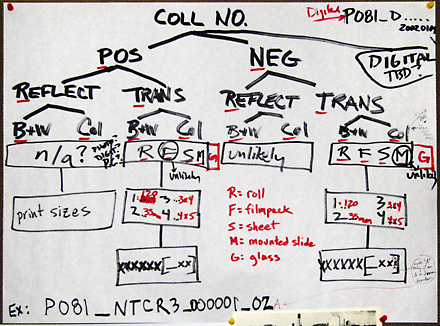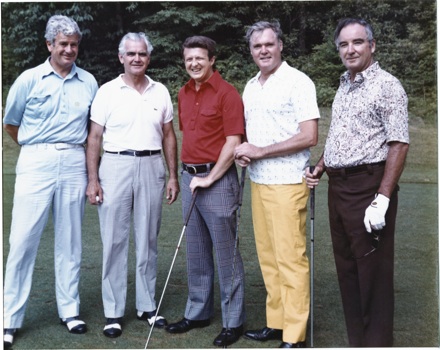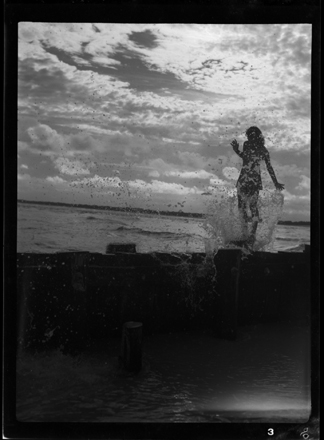 I gave a quick “tour” of the Morton collection recently to a group of local archivists who specialize in audio-visual materials, and after explaining a bit to them about the file naming scheme we’ve adopted, they suggested I share it on the blog. WARNING: some may find this a bit dry, but hopefully it will be useful (or at least mildly interesting) to others.
I gave a quick “tour” of the Morton collection recently to a group of local archivists who specialize in audio-visual materials, and after explaining a bit to them about the file naming scheme we’ve adopted, they suggested I share it on the blog. WARNING: some may find this a bit dry, but hopefully it will be useful (or at least mildly interesting) to others. All the scanning David’s doing presents a number of challenges, one of which is how to name the digital files he creates. Some quick background: as I briefly explained in my post on mass digitization, we are going about scanning in a somewhat unusual manner, in that we’re beginning to scan the collection in the middle of processing it, rather than waiting until the end. We’re doing this because 1) we don’t want to wait that long to make Morton’s images available on the web, and 2) we’re hoping to use scanning as a processing tool, helping us to view negatives more easily and to bring like materials (e.g., images shot at the same event but on different film formats) back together again.
All the scanning David’s doing presents a number of challenges, one of which is how to name the digital files he creates. Some quick background: as I briefly explained in my post on mass digitization, we are going about scanning in a somewhat unusual manner, in that we’re beginning to scan the collection in the middle of processing it, rather than waiting until the end. We’re doing this because 1) we don’t want to wait that long to make Morton’s images available on the web, and 2) we’re hoping to use scanning as a processing tool, helping us to view negatives more easily and to bring like materials (e.g., images shot at the same event but on different film formats) back together again.
For these and other reasons, we decided to base our naming/numbering system on the format of the original item. For one thing, when you’re looking at a scanned image, you have no way to tell whether the original was a print, a negative, slide, transparency, etc.—we wanted the file name to give us this information. So, here’s an sample image and file name:
P081_NTBF3_000132_03
- P081 is our collection number for the Hugh Morton
- N stands for negative (this could also be “P” for positive)
- T stands for transparency (this could also be “R” for reflective, e.g., a photographic print)
- B stands for black & white (this could also be “C” for color)
- F stands for film pack (this could also be “S” for sheet film, “R” for roll film, “P” for print, or “M” for mounted slide)
- 3 indicates the size of the original, in this case 3″ x 4″ (this could also be 4 for 4″x5″, 2 for 35mm, 8 for an 8″ x 10″ print, or one of the many other numeric codes we came up with to indicate size)
- The six digit number is our running “lot” number to provide a unique identified for every image
- The last two digit number indicates the frame number (only film packs and roll films have this)
Here’s another sample—see if you can decipher this image’s original format.

P081_PRCP8_000273
And while we’re at it, does anyone know who these gentlemen are? I recognize Gen. William Westmoreland (2nd from left), and former NC Governor James Holshouser in the middle, but I need help with the others.
We’re not far enough along in our process yet to fully judge the usefulness of this naming scheme, but it does seem that it would be most applicable to collections with very little existing organization (like the Morton). We’ll let you know how it goes. Any thoughts, ideas, suggestions?


Greetings! It appears to me that the man second from the right is a young Tommy Bradford from Fayetteville. Tommy and I went to Fayetteville High School together and played football in the mid-60s. Tommy was a big time player, fullback, All State and went to NC State where he starred as well. He is now in the construction business here in Fayetteville. Hope this helps! Congrats!
(L-R) is Blake Clark (former club president at Grandfather Golf & Country Club), Gen. William Westmoreland, Gov. Jim Holshouser, not sure, John Williams (Hugh Morton’s partner in developing GGCC).
Original Image Format for P081_PRCP8_000273:
My guess is that this is a Hugh Morton Positive Reflective Photographic 8×10 Color Print from Print Film. The image has a lot number of 000273.
Nice work, Jack–you’ve deciphered the file naming system! And thanks to other commenters for the IDs. Anyone have a guess as to when the golf photo was taken?
Holshouser was elected Governor on November 7, 1972, and Wesstmoreland completed his military service on June 30, 1972. In this picture, Holshouser looks a lot like he did when he was elected Governor. The clothing would indicate warm weather. According to the 1974 Highland Games Program and Review (page 18), General Westmoreland was a guest at the ’73 Games. Did Holshouser attend in ’73?
My guess for this picture would be July, 1973.
Two more quick comments about the date of the golf picture.
(1) In Hugh Morton’s 2003 book, “Hugh Morton’s North Carolina,” on page 89, there is a picture of James Holshouser speaking at the 1975 “Singing on the Mountain.” The caption reads in part, “…Governor James E. Holshouser, from Boone, returned to the Mountain to be principal speaker…” The key word here is “returned.”
(2) In Hugh’s 1988 book, “Making A Difference in North Carolina,” on pages 246 and 247, there is a picture of Holshouser and Westmoreland with others. There isn’t a date with this picture, but Holshouser appears to be dressed the same as in the 1975 “Singing” picture.
So, the date of the golf picture could be June, 1975.
very interesting naming scheme. the only comment I have is that you lack a date field. you could put a date field right after the collection number
P_yyyy_
or
P_YY
the first would allow all images to be sorted by the year they were taken, the latter would not be as useful since all 21st c photos would be first ie P081_02 appears before P081_99
Peter, thanks for your comment on the naming scheme. I agree that having a date in the file name would be very useful, but it’s not practical for this project because we have SO MANY undated images. For many (i.e., scenic photos), we can’t even narrow it down to a specific decade!